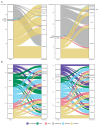The Omicron Lineages BA.1 and BA.2 (Betacoronavirus SARS-CoV-2) Have Repeatedly Entered Brazil through a Single Dispersal Hub
- PMID: 37112869
- PMCID: PMC10146814
- DOI: 10.3390/v15040888
The Omicron Lineages BA.1 and BA.2 (Betacoronavirus SARS-CoV-2) Have Repeatedly Entered Brazil through a Single Dispersal Hub
Abstract
Brazil currently ranks second in absolute deaths by COVID-19, even though most of its population has completed the vaccination protocol. With the introduction of Omicron in late 2021, the number of COVID-19 cases soared once again in the country. We investigated in this work how lineages BA.1 and BA.2 entered and spread in the country by sequencing 2173 new SARS-CoV-2 genomes collected between October 2021 and April 2022 and analyzing them in addition to more than 18,000 publicly available sequences with phylodynamic methods. We registered that Omicron was present in Brazil as early as 16 November 2021 and by January 2022 was already more than 99% of samples. More importantly, we detected that Omicron has been mostly imported through the state of São Paulo, which in turn dispersed the lineages to other states and regions of Brazil. This knowledge can be used to implement more efficient non-pharmaceutical interventions against the introduction of new SARS-CoV variants focused on surveillance of airports and ground transportation.
Keywords: COVID-19; dispersal; genome; phylodynamics; variant of concern; viral evolution.
Conflict of interest statement
The authors declare no conflict of interest.
Figures



References
-
- World Health Organization WHO Coronavirus (COVID-19) Dashboard. [(accessed on 27 September 2022)]. Available online: https://covid19.who.int.
Publication types
MeSH terms
LinkOut - more resources
Full Text Sources
Medical
Miscellaneous

